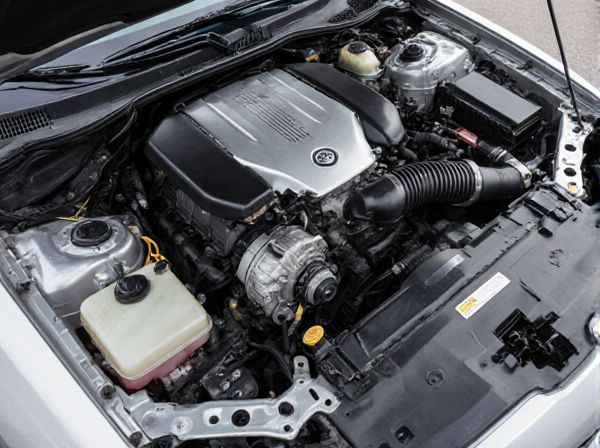
Photo illustration: 4-Stroke vs 2-Stroke
4-stroke engines deliver better fuel efficiency and lower emissions due to their separate intake, compression, power, and exhaust strokes, making them ideal for everyday use and longevity. 2-stroke engines provide higher power-to-weight ratios and simpler mechanics, offering quicker acceleration and easier maintenance but typically consume more fuel and produce more pollution. Your choice depends on whether you prioritize performance and lightness or fuel economy and environmental impact.
Table of Comparison
| Feature | 4-Stroke Engine | 2-Stroke Engine |
|---|---|---|
| Power Cycle | Four distinct strokes: intake, compression, power, exhaust | Two strokes combining compression and power phases |
| Efficiency | Higher fuel efficiency, better combustion control | Lower fuel efficiency due to incomplete combustion |
| Emissions | Lower emissions, environmentally friendly | Higher emissions, more pollution |
| Power Output | Less power per weight, smoother delivery | Higher power-to-weight ratio, more power bursts |
| Maintenance | More complex, requires regular oil changes | Simple design, easier and cheaper maintenance |
| Typical Applications | Cars, motorcycles, lawnmowers | Chainsaws, dirt bikes, small engines |
Understanding 4-Stroke and 2-Stroke Engines
4-stroke engines complete a power cycle in four piston strokes--intake, compression, power, and exhaust--resulting in efficient fuel combustion and lower emissions. 2-stroke engines combine these processes into two strokes, producing more power per revolution but often emitting higher pollutants due to incomplete combustion. Understanding these differences helps in selecting the appropriate engine type for applications prioritizing fuel efficiency or power output.
Key Differences in Engine Design
4-stroke engines feature four distinct cycles: intake, compression, power, and exhaust, utilizing separate strokes for each phase, resulting in higher fuel efficiency and lower emissions. In contrast, 2-stroke engines combine these processes into two strokes, allowing for a simpler design and higher power-to-weight ratio but often producing more pollution. The presence of valves in 4-stroke engines versus ports in 2-stroke engines significantly influences performance, maintenance, and environmental impact.
Performance Comparison: Power and Efficiency
4-stroke engines deliver smoother power output and better fuel efficiency due to their complete combustion cycle, making them ideal for applications requiring consistent torque and lower emissions. 2-stroke engines produce higher power-to-weight ratios by firing once every revolution, resulting in increased power output but lower fuel efficiency and higher emissions. Performance-wise, 4-stroke engines excel in durability and efficiency, while 2-stroke engines prioritize maximum power and lighter weight for high-performance demands.
Fuel Consumption and Economy
4-stroke engines generally offer better fuel economy and lower fuel consumption compared to 2-stroke engines due to their more efficient combustion process and separate intake, compression, power, and exhaust strokes. 2-stroke engines consume more fuel as they mix oil with fuel for lubrication, leading to incomplete combustion and higher emissions. In applications where fuel efficiency and reduced operating costs are critical, 4-stroke engines are preferred despite their higher initial cost and complexity.
Maintenance Requirements and Lifespan
4-Stroke engines require more complex maintenance due to their separate lubrication system, including regular oil changes and valve adjustments, but they typically offer a longer lifespan exceeding 1,000 operational hours. In contrast, 2-Stroke engines feature simpler maintenance with fewer moving parts and no separate oil system, but they have a shorter lifespan often under 500 hours due to higher wear rates from mixed fuel lubrication. Proper maintenance adherence significantly impacts the durability and performance of both engine types.
Environmental Impact and Emissions
4-stroke engines emit significantly fewer pollutants such as hydrocarbons, carbon monoxide, and nitrogen oxides compared to 2-stroke engines due to their complete combustion process and separate intake and exhaust strokes. 2-stroke engines, commonly used in smaller equipment, tend to release unburned fuel and oil directly into the environment, resulting in higher emissions and increased air pollution. Regulatory bodies increasingly favor 4-stroke technology to reduce environmental impact and meet stringent emission standards.
Noise Levels and Riding Experience
4-stroke engines produce significantly lower noise levels compared to 2-stroke engines due to their more controlled combustion process and additional valve mechanisms. Riders experience smoother acceleration and reduced vibration with 4-stroke engines, enhancing comfort during longer rides. In contrast, 2-stroke engines deliver a sharper, more aggressive throttle response and higher-pitched exhaust note, appealing to enthusiasts seeking a more exhilarating and raw riding experience.
Popular Applications and Industry Uses
4-stroke engines dominate automotive, marine, and industrial machinery sectors due to their fuel efficiency and lower emissions, making them ideal for cars, motorcycles, lawnmowers, and generators. 2-stroke engines are preferred in applications requiring lightweight and high power-to-weight ratio, such as chainsaws, dirt bikes, and outboard motors. The choice between 4-stroke and 2-stroke engines depends on performance needs, environmental regulations, and maintenance considerations within industries like agriculture, forestry, and recreational sports.
Pros and Cons of 4-Stroke Engines
4-stroke engines offer greater fuel efficiency and lower emissions compared to 2-stroke engines, making them environmentally friendlier and cost-effective over time. Their complex valve mechanism ensures smoother operation and better torque delivery at lower RPMs, but this design also results in increased weight and higher manufacturing costs. Maintenance for 4-stroke engines is generally more involved due to the additional components, though they provide longer engine life and enhanced reliability.
Pros and Cons of 2-Stroke Engines
2-stroke engines offer a higher power-to-weight ratio and simpler design, making them ideal for lightweight applications such as dirt bikes and chainsaws. However, they tend to produce more emissions and consume fuel less efficiently compared to 4-stroke engines, resulting in environmental concerns. Their increased wear and shorter lifespan also contribute to higher maintenance costs over time.
 caratoz.com
caratoz.com